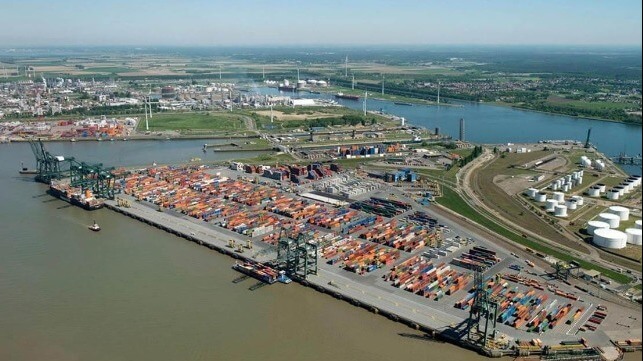Renewal of Europa Terminal at Port of Antwerp-Bruges Underway

Today, 6 October, Port of Antwerp-Bruges and PSA Antwerp gave the official green light for the renewal of the quayside and terminal at Europa Terminal. The works, which will take about nine years and be carried out in three phases, will ensure that the latest generation of container ships can continue to call at Antwerp. These renovations will also result in an efficient and sustainable terminal that contributes to the transition towards a climate-neutral port.
In order to remain a top-class world port, it must be able to offer its customers a well-functioning infrastructure and additional container capacity. Port of Antwerp-Bruges and PSA Antwerp are therefore investing in the renewal of the Europa Terminal. It was officially inaugurated in 1990 as the first tidal container terminal in Antwerp. With the renewal, which will cost €335 million, Port of Antwerp-Bruges aims to strengthen its competitive position while taking steps towards becoming a sustainable port.
Works carried out in three phases to keep the terminal operational
The depth of vessels that can moor at the 1,200-metre quayside will be increased from 13.5 metres to 16 metres. Because ships must be able to continue to moor during the extensive works and in order to minimise operational impact, the port authorities are tackling the quayside in three major phases. In addition, they will create additional temporary moorings for inland navigation, so it can guarantee that its customers will receive a smooth service. The works will be spread over about nine years and have been carefully plotted based on expected traffic.
Attention to climate and the environment
The renovation of the terminal will also contribute to the transition towards a climate-neutral port. Electrification and other optimisations will reduce CO2 emissions per container by 50% and wind turbines will increase the share of renewable energy.
The new quayside will be given a new orientation to ensure sufficient distance between passing ships and the terminal, and to protect the nearby Galgenschoor nature reserve. The works include in the final phase the construction of an underwater dam to provide additional protection for the nature reserve and ensure it does not subside.

that matters most
Get the latest maritime news delivered to your inbox daily.
During the entire process, all parties involved will take the necessary measures to minimise disruption, in close consultation with the surrounding area.
Following a tender process, the contract for the works was concluded today with a temporary company of four contractors, Artes-Roegiers, Artes-Depret, Herbosch-Kiere and Boskalis, all with extensive experience in large-scale hydraulic engineering projects.
The products and services herein described in this press release are not endorsed by The Maritime Executive.
